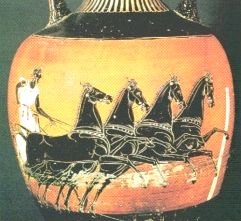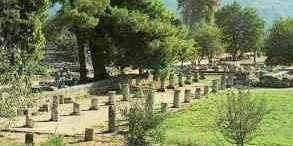
The Greeks invented
athletic contests and held them in honour of their gods. The Isthmos
game were staged every two years at the Isthmos of Corinth. The Pythian
games took place every four years near Delphi. The most famous games
held at Olympia, South- West of Greece, which took place every four
years. The ancient Olympics seem to have begun in the early 700 BC, in
honour of Zeus. No women were allowed to watch the games and only Greek
nationals could participate. One of the ancient wonders was a statue of
Zeus at Olympia, made of gold and ivory by a Greek sculptor Pheidias.
This was placed inside a Temple, although it was a towering 42 feet
high.

The games at Olympia were greatly expanded from a one-day
festival of athletics and wrestling to, in 472 BC, five days with many
events. The order of the events is not precisely known, but the first
day of the festival was devoted to sacrifices. On the Middle Day of the
festival 100 oxen were sacrificed in honor of a God. Athletes also
often prayed and made small sacrifices themselves..
On the
second day, the foot-race, the main event of the games, took place in
the stadium, an oblong area enclosed by sloping banks of earth.
At
Olympia there were 4 different types of races; The first was stadion,
the oldest event of the Games, where runners sprinted for 1 stade, the
length of the stadium(192m). The other races were a 2-stade race (384
m.), and a long-distance run which ranged from 7 to 24 stades (1,344 m.
to 4,608 m.).The fourth type of race involved runners wearing full
amor, which was 2-4 stade race (384 m. to 768 m.), used to build up
speed and stamina for military purposes.
On other days,
wrestling, boxing, and the pancratium, a combination of the two, were
held. In wrestling, the aim was to throw the opponent to the ground
three times, on either his hip, back or shoulder. In ancient Greek
wrestling biting and genital holds were illegal.
Boxing
became more and more brutal; at first the pugilists wound straps of
soft leather over their fingers as a means of deadening the blows, but
in later times hard leather, sometimes weighted with metal, was used.
In the pancratium, the most rigorous of the sports, the contest
continued until one or the other of the participants acknowledged
defeat.
Horse-racing, in which each entrant owned his horse,
was confined to the wealthy but was nevertheless a popular attraction.
The course was 6 laps of the track, with separate races for whereupon
the rider would have no stirrups. It was only wealthy people that could
pay for such training, equipment, and feed of both the rider and the
horses. So whichever horse won it was not the rider who was awarded the
Olive wreath but the owner. There were also Chariot races, that
consisted of both 2-horse and 4-horse chariot races, with separate
races for chariots drawn by foals. There was also a race was between
carts drawn by a team of 2 mules, which was 12 laps of the stadium
track.

Greek
Chariot Racing
After the horse-racing came the pentathlon, a series of
five events: sprinting, long-jumping, javelin-hurling, discus-throwing,
and wrestling.
The ancient Greeks considered the rhythm and precision of an athlete throwing the discus as important as his strength.
The discus was a circle shaped stone, iron, bronze, or lead. There were
different sizes according to age groups. The javelin was a long wooden
stick shape with spear head, similar height to that of a person. In the
middle was bound a thong for a hurler's fingers to grip and guide to
the correct angle it was thrown.
To Jump long distances athletes
used lead or stone weights to increase the length of the jump. These
weights were known as 'halteres' were held in front of the athlete
during his ascent, and then swung behind his back and dropped during
his descent to help propel him.

Olympic
Gymnasium 776 BC
I'm sure you're redy to post a full version of the Olympic Games History!

With friendship,
Anamaria